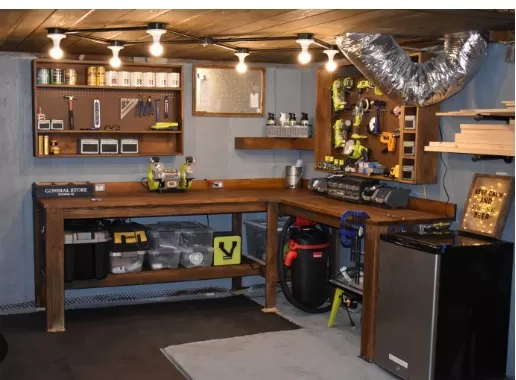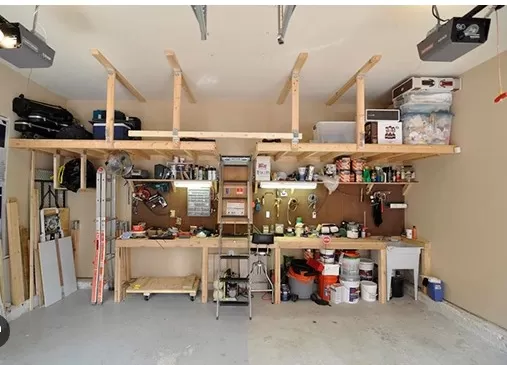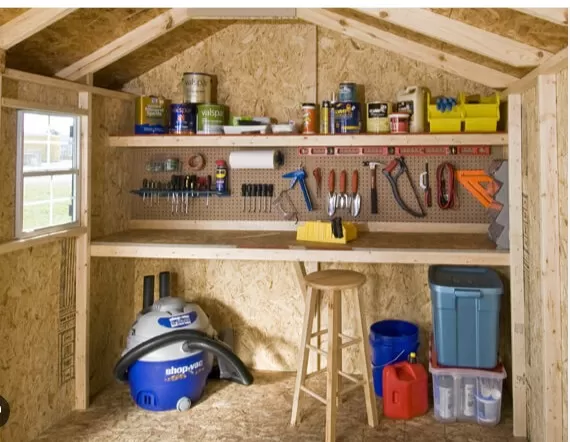Home Workshop Setup: Essential Ways to Get Started. Deciding on the location for your workshop is essential to ensure optimal functionality and comfort. While it’s ideal to choose a space where noise, dust, and space constraints are minimal, there are other important factors to consider.
Factors such as humidity, light, and ventilation play crucial roles in creating a suitable workshop environment. High humidity can damage tools and materials, so it’s important to choose a space with proper humidity control or consider using dehumidifiers. Sufficient lighting is essential for visibility and safety, so make sure your workshop has adequate natural light or invest in appropriate lighting fixtures. Proper ventilation is necessary to remove dust, fumes, and odors, so consider installing fans or ventilation systems to maintain good Air Quality. Additionally, consider the layout and organization of your tools and materials to optimize workflow and efficiency in your workshop. By carefully considering these factors and following our guide, you can create a functional and comfortable workspace, regardless of where you choose to set up your workshop.
Creating an Attic Workshop: Important Considerations

If you’re considering turning your attic into a workshop, there are several crucial factors to keep in mind.
Follow these guidelines to ensure a successful and safe transformation:.
Check Ceiling Height: Before proceeding, measure the height of your attic space.
It’s essential to have enough headroom to stand comfortably and maneuver without feeling cramped. Consider the height of yourself and any tall materials you plan to work with, such as wooden boards.
Assess Access Route: Evaluate the access route to your attic.
If you have steep or narrow stairs, it can be challenging to transport heavy materials, tools, and finished projects safely. Ensure that you have a clear and easy path to carry items up and down from the attic.
Test Attic Floors: Verify the strength and stability of your attic floors before setting up a workshop.
Attics are not always designed to handle heavy loads. Consult a professional or a structural engineer to evaluate the floor’s capacity and make any necessary reinforcements.
Ensure Proper Ventilation: Attics can become hot and stuffy, especially during warmer months.
Install an exhaust fan or other ventilation system to maintain a comfortable and healthy workshop environment. Proper ventilation helps control temperature, humidity, and air quality.
Research Expert Advice: Explore reputable sources and seek advice from experienced individuals who have converted their attics into workshops.
Todd Fratzel’s Home Construction & Improvement website is one resource that provides insights and tips specific to attic workshops.
Plan for Storage and Organization: Consider the layout of your workshop and incorporate adequate storage and organization solutions.
Utilize wall-mounted shelves, pegboards, or tool cabinets to keep your workspace tidy and accessible. Maximize the use of vertical space to optimize the available area.
Safety First: Prioritize safety in your attic workshop.
Install proper lighting to ensure visibility, and ensure that electrical outlets and wiring meet code requirements. Use sturdy workbenches and secure tools properly.
Implement fire safety measures, such as smoke detectors and fire extinguishers.
Remember, converting an attic into a workshop requires careful planning and consideration of various factors.
By assessing the ceiling height, access route, floor strength, ventilation, and expert advice, you can create a functional and safe workspace that maximizes the potential of your attic.
Creating a Bedroom Workshop for Practicality
While it may seem unconventional, one college student found it most practical to establish a home workshop in their bedroom.
Although many homeowners would prefer utilizing a spare bedroom or office for such purposes, this unique approach eliminates concerns regarding safety, noise, and air quality in the room dedicated to restful nights.
Creating a Backyard Workshop: Considerations and Tips

Turning your backyard into a workshop can offer a convenient and spacious working environment.
Consider the following factors and tips to ensure a successful backyard workshop setup:.
Check Local Regulations: Before setting up a workshop in your backyard, familiarize yourself with local regulations and any permits or zoning restrictions that may apply.
Ensure compliance with noise ordinances, setback requirements, and any other relevant regulations.
Good Neighbor Relations: Maintain a positive relationship with your neighbors, especially if your tools and equipment generate noise.
Communicate with them about your plans and be mindful of working hours to minimize disruptions. Consider using quieter tools or implementing noise-reducing measures, such as soundproofing your workshop space.
Weather Protection: Monitor the weather forecast and prepare your backyard workshop for different conditions.
Extreme heat, rain, and other weather elements can affect both you and your equipment. Consider installing shade structures, canopies, or a covered workspace to provide protection from the sun and rain.
Ensure your tools and materials are stored in waterproof containers or an indoor space to prevent damage.
Pest Control: Take measures to prevent pests from disturbing your backyard workshop.
Seal any gaps or entry points that pests could use to access your workspace. Regularly inspect and clean the area to minimize potential nesting sites.
Consider using pest control methods that are safe and appropriate for your backyard environment.
Organized Storage: Designate specific areas or storage solutions for your tools, equipment, and supplies.
Utilize shelves, cabinets, or tool chests to keep your workspace organized and efficient. Proper storage not only enhances productivity but also helps protect your tools from damage and extends their lifespan.
Outdoor Safety Measures: Ensure a safe working environment by implementing outdoor safety measures.
Install proper lighting for visibility, especially if you plan to work during evenings or in low-light conditions. Consider installing outdoor electrical outlets in safe locations to avoid using extension cords that may pose tripping hazards.
Secure and Lockable Storage: Protect your tools and equipment from theft by providing secure storage options.
Install lockable cabinets, tool chests, or a lockable shed to store valuable items when not in use. Implement additional security measures such as motion sensor lights or security cameras if necessary.
Remember to prioritize safety, organization, and good relations with neighbors when setting up a backyard workshop.
With proper planning, you can create a functional and enjoyable workspace that maximizes the advantages of working in your own outdoor haven.
Setting Up a Freestanding Workshop: Considerations and Tips
A freestanding workshop, such as a prefab shed or a custom-built structure, offers dedicated space for your craft and allows you to have full control over its design and functionality.
Here are some considerations and tips for creating a successful freestanding workshop:.
Assess Space and Size: Determine the amount of space you need for your workshop, considering the type of projects you undertake and the tools and equipment you use.
Assess the available area in your backyard and ensure the workshop size meets your requirements without overwhelming the space.
Prefab Shed or Custom Build: Decide whether you want to purchase a prefabricated shed or build your own workshop from scratch.
Prefab sheds provide convenience and can be customized to some extent. Building your own workshop allows for complete customization to fit your specific needs, but it requires more time and construction skills.
Lighting: Adequate lighting is essential for a functional workshop.
Consider incorporating windows, skylights, or translucent panels into the design to allow natural light to illuminate the space during the day. Additionally, install proper electric lighting fixtures to ensure ample visibility for detailed work and evening hours.
Ventilation: Proper ventilation is crucial for safety and comfort.
Freestanding workshops can become hot and stuffy, especially during warm seasons. Install windows that can be opened for cross-ventilation or consider adding vents and fans to improve air circulation and reduce the build-up of fumes or dust.
Layout and Organization: Plan your workshop layout thoughtfully to optimize workflow and productivity.
Designate areas for different activities, such as a workbench, tool storage, and assembly space. Utilize pegboards, wall-mounted shelves, and drawers to keep tools and materials organized and easily accessible.
Safety Precautions: Prioritize safety in your freestanding workshop.
Install appropriate safety features such as fire extinguishers, first aid kits, and emergency exits. Consider implementing dust collection systems or wearing personal protective equipment (PPE) to minimize health hazards.
Additionally, ensure proper electrical wiring and outlets meet safety standards.
Security: Protect your workshop and its contents by implementing security measures.
Install sturdy doors and windows with reliable locks. Consider adding motion sensor lights or a security system to deter theft and provide peace of mind.
Permit and Code Compliance: Check local building codes and obtain any necessary permits before constructing or installing a freestanding workshop.
Compliance with regulations ensures the safety and legality of your workshop.
Remember to customize your freestanding workshop to suit your specific needs and preferences.
It should provide a functional and inspiring space where you can pursue your craft while ensuring safety and efficiency.
Setting Up a Basement Workshop: Tips and Considerations

Creating a workshop in your basement can be a practical and convenient solution.
Here are some tips and considerations to keep in mind for a successful basement workshop setup:.
Seclusion and Soundproofing: One advantage of a basement workshop is its seclusion from the rest of the home.
This allows for a quieter working environment and reduces the disruption to others in the house. However, keep in mind that sound can still travel, so consider implementing soundproofing measures like insulation, acoustic panels, or heavy curtains.
Dealing with Dampness: Basements are prone to dampness and high humidity levels, which can be detrimental to tools, equipment, and the overall workshop environment.
Ensure good ventilation by installing exhaust fans or opening windows to allow for air circulation. Use a dehumidifier if necessary to control moisture levels and prevent damage to tools and materials.
Lighting: Basements typically have limited natural light, so proper lighting is crucial for your workshop.
Install bright and efficient lighting fixtures, such as LED lights or fluorescent tubes, to ensure good visibility. Consider task lighting for specific work areas and supplement with natural light sources like windows or light wells, if available.
Storage and Organization: Designate specific areas for tool storage, workbenches, and assembly areas in your basement workshop.
Utilize shelving units, pegboards, and drawers to keep your tools and materials organized and easily accessible. Maximize vertical space by using wall-mounted storage solutions.
Electrical Considerations: Ensure that your basement workshop has sufficient electrical outlets to meet your power needs.
Consult a licensed electrician to evaluate and upgrade your electrical system if necessary. Use surge protectors and proper grounding to protect your tools and equipment.
Fire Safety: Basements may have additional fire safety concerns due to limited exit options.
Install smoke detectors and fire extinguishers in strategic locations. Maintain clear and unobstructed pathways to exits and have an emergency plan in place.
Proper Ventilation and Air Filtration: In addition to controlling dampness, proper ventilation helps remove fumes and airborne particles generated by woodworking or other projects.
Consider using an air filtration system or portable air purifier to improve indoor air quality and reduce health risks.
Workbench and Workshop Layout: Plan your basement workshop layout carefully to optimize workflow and maximize available space.
Customize your workbench to fit your needs, incorporating features like tool storage, power outlets, and adjustable height. Ensure that your workshop layout allows for comfortable movement and efficient use of tools and equipment.
Remember to regularly inspect and maintain your basement workshop to address any potential issues promptly.
Regularly clean and organize the space to promote safety and efficiency. With proper planning, ventilation, and organization, a basement workshop can become a functional and productive space for pursuing your craft.
*The information is for reference only.